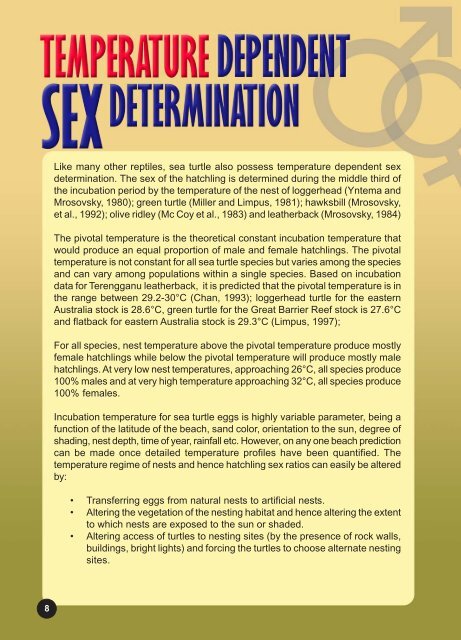Sea Turtle Hatchery - seafdec.org.my
Sea Turtle Hatchery - seafdec.org.my
Sea Turtle Hatchery - seafdec.org.my
You also want an ePaper? Increase the reach of your titles
YUMPU automatically turns print PDFs into web optimized ePapers that Google loves.
Like many other reptiles, sea turtle also possess temperature dependent sex<br />
determination. The sex of the hatchling is determined during the middle third of<br />
the incubation period by the temperature of the nest of loggerhead (Yntema and<br />
Mrosovsky, 1980); green turtle (Miller and Limpus, 1981); hawksbill (Mrosovsky,<br />
et al., 1992); olive ridley (Mc Coy et al., 1983) and leatherback (Mrosovsky, 1984)<br />
The pivotal temperature is the theoretical constant incubation temperature that<br />
would produce an equal proportion of male and female hatchlings. The pivotal<br />
temperature is not constant for all sea turtle species but varies among the species<br />
and can vary among populations within a single species. Based on incubation<br />
data for Terengganu leatherback, it is predicted that the pivotal temperature is in<br />
the range between 29.2-30°C (Chan, 1993); loggerhead turtle for the eastern<br />
Australia stock is 28.6°C, green turtle for the Great Barrier Reef stock is 27.6°C<br />
and flatback for eastern Australia stock is 29.3°C (Limpus, 1997);<br />
For all species, nest temperature above the pivotal temperature produce mostly<br />
female hatchlings while below the pivotal temperature will produce mostly male<br />
hatchlings. At very low nest temperatures, approaching 26°C, all species produce<br />
100% males and at very high temperature approaching 32°C, all species produce<br />
100% females.<br />
Incubation temperature for sea turtle eggs is highly variable parameter, being a<br />
function of the latitude of the beach, sand color, orientation to the sun, degree of<br />
shading, nest depth, time of year, rainfall etc. However, on any one beach prediction<br />
can be made once detailed temperature profiles have been quantified. The<br />
temperature regime of nests and hence hatchling sex ratios can easily be altered<br />
by:<br />
• Transferring eggs from natural nests to artificial nests.<br />
• Altering the vegetation of the nesting habitat and hence altering the extent<br />
to which nests are exposed to the sun or shaded.<br />
• Altering access of turtles to nesting sites (by the presence of rock walls,<br />
buildings, bright lights) and forcing the turtles to choose alternate nesting<br />
sites.<br />
8

















